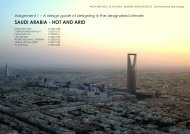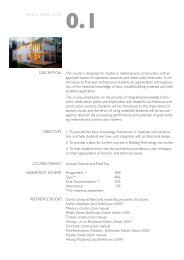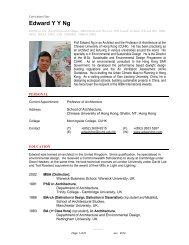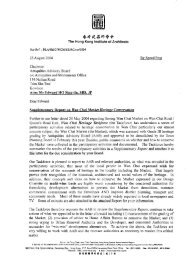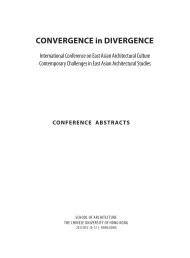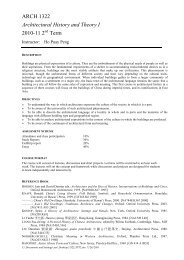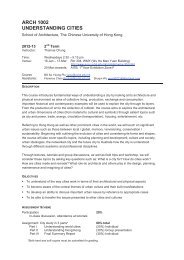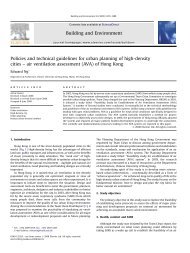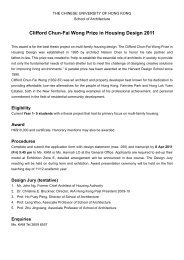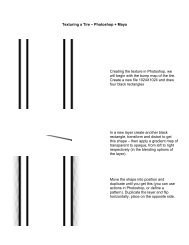Notebook III - School of Architecture - The Chinese University of ...
Notebook III - School of Architecture - The Chinese University of ...
Notebook III - School of Architecture - The Chinese University of ...
You also want an ePaper? Increase the reach of your titles
YUMPU automatically turns print PDFs into web optimized ePapers that Google loves.
notebook<br />
<strong>Notebook</strong> <strong>III</strong><br />
2 This is the third working notebook <strong>of</strong> the due general consideration to all. <strong>The</strong> thesis is <strong>of</strong> the studios. It is also conducted in a number<br />
3<br />
architecture programme. It describes the<br />
programme in its present state as it has developed<br />
since its inception in 2001.<br />
During this development the fundamental<br />
structure and ideas have remained much<br />
the same and have continued to provide a<br />
common ground in the department for teaching,<br />
research, and discourse at all levels.<br />
In design, teaching has continued in the four<br />
primary studios: habitation, urbanization, technics,<br />
and tectonics, with participation in all four<br />
from all levels <strong>of</strong> students.<br />
However, the experiences <strong>of</strong> the year have led<br />
to two further developments.<br />
1. Research on the position <strong>of</strong> each studio is<br />
explicitly recognized as the basis for teaching,<br />
leading to greater articulation <strong>of</strong> the historical,<br />
theoretical, and critical foundations <strong>of</strong> the<br />
studio. A series <strong>of</strong> seminars / presentations<br />
based on this research accompanies the<br />
design programme <strong>of</strong> each studio.<br />
2. A greater distinction is made between<br />
the undergraduate and graduate work. <strong>The</strong><br />
graduate student is expected to have fulfilled<br />
the design requirements <strong>of</strong> all four primary<br />
studios and be able to design from a focused<br />
position – <strong>of</strong> any <strong>of</strong> the studios, but with<br />
expected to present an articulate personal<br />
position in design which can be presented<br />
theoretically and practically in terms <strong>of</strong> “primary<br />
positions” such as the four in the undergraduate<br />
programme.<br />
In humanities, the courses more clearly<br />
present the relationship between history,<br />
theory, and criticism. Each course in the<br />
undergraduate programme engages all three<br />
areas, while in the graduate programme elective<br />
courses deal with these in a more specialized<br />
manner.<br />
In technology, the distinction between courses<br />
in construction, structures, and environment<br />
is addressed in the graduate programme in<br />
specialized courses and separate subjects with<br />
their distinct body <strong>of</strong> theory. In the undergraduate<br />
programme, issues in these areas are<br />
presented as aspects <strong>of</strong> one unified subject:<br />
technology. This emphasizes the unity <strong>of</strong> technological<br />
considerations in the real building<br />
while recognizing that advanced study requires<br />
specific theoretical knowledge <strong>of</strong> each one.<br />
Research has gained a clearer position in the<br />
programme as a whole. <strong>The</strong> programme <strong>of</strong><br />
teaching is supported by a parallel programme<br />
<strong>of</strong> research. Both are based on the same ideas<br />
and structure in architecture and education.<br />
<strong>The</strong> research is not only integral to the work<br />
<strong>of</strong> research units. <strong>The</strong>se form a group which<br />
supports the teaching programme particularly<br />
at the graduate level, and conducts funded<br />
research and development.



